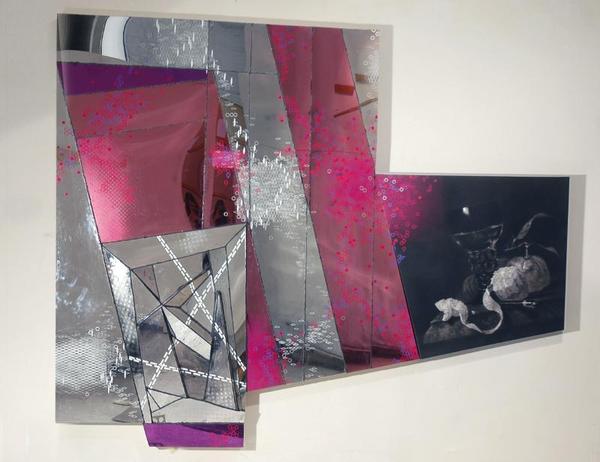This is an archive of the ArtCat Zine, 2007-2009. Please visit our new project, IDIOM.
Shimon Okshteyn at Heist
Shimon Okshteyn
Heist Gallery - Shimon Okshteyn at Heist, New York NY
10 October - 7 November 2008
For one more week, merry wanderers and afternoon flâneurs can find a funhouse gallery of mirrors hidden on a quiet block of Chinatown. Tucked between two small shops on Essex Street south of Delancey, you can enter a wormhole that will send you back to a Coney Island spectacle or a Times Square peep show. But peek around the corner of a mirror and you will see nary an amusement ride technician nor a beautiful girl, but a cheerful gallery attendant eager to hand you a press release.
Shimon Okshteyn's show, Reflection on Reality, is the fourth exhibition at the newly opened Heist Gallery located in eastern Chinatown. The immersive installation, including a mirrored floor, is made up of slightly distorted mirrors bolted to the gallery walls. The mirrors swell and contract light and splinter where the screws bite. Thin purple and pink neon bulbs light the hall, bouncing against the opposing mirrors, and illuminating the space with an appropriately artificial glow.
The focal piece of the exhibition is a voluminous protrusion of glass that juts out of the left gallery wall. Composed of broken glass sutured together to form a small peak, the horizontal mountain is surrounded by painted canvas, and decorated with a graphic lace-like pattern. The rupture is wonderfully frightening, a 3-D realization of the sinister curiosity that leads us to the hedonistic spaces of amusement parks and red light districts.
Okshteyn does undermine some of this darkness with what looks like a computer-generated decorative overlay. But what he takes away, he gives back in a small painting titled Julie, an image of a woman post-coital. On its own the work is charmingly rough, endearing in its earnest simplicity. Coupled with Boy Smoking, a slightly larger painting of a boy doing just that, and placed in this seedy and otherwise reflective context, the works charm while making sure gallery goers catch the sexual undertone.
The strength of Okshteyn's exhibition comes not from the material installation or individual works here on display, but rather from the totality of the exhibition as both environment and an unlikely observation deck for the surrounding neighborhood. The most interesting vantage point is at the far back of the narrow gallery space, looking out. Standing against the back wall, the glittery mirrors frame a captivating view of the life of the Lower East Side breathing and moving outside the gallery window.
Only a handful of blocks south of the glossy bars, nightclubs, and organic markets that now suffocate the once Caribbean and Italian arteries of the Lower East Side, Essex Street between Hester and Grand remains a relatively unblemished stretch of Chinatown. Across the street, past the slightly beat up Toyota and Ford sedans, is a modest basketball court presided over by the forlorn towers of Cooperative Village. Although Heist Gallery is one of the several cultural enterprises that dot the neighborhood map, for the length of Okshteyn's show they provide something unique: a remarkable opportunity to sit and appreciate the comforting banality of everyday life that still has a place in this small corner of lower Manhattan.
ZINE
HOME
TIPS / COMMENTS
CATEGORIES
CONTRIBUTORS
- Greg Afinogenov
- B. Blagojevic
- Adda Birnir
- Susannah Edelbaum
- Julie Fishkin
- Paddy Johnson
- Jessica Loudis
- Christopher Reiger
- Andrew Robinson
- Peter J. Russo
- Blythe Sheldon
- S.C.Squibb
- Hrag Vartanian

